| Article ID | Journal | Published Year | Pages | File Type |
|---|---|---|---|---|
| 2436791 | International Journal for Parasitology | 2009 | 9 Pages |
The cosmopolitan parasitic pathogen Toxoplasma gondii is capable of infecting essentially any warm-blooded vertebrate worldwide, including most birds and mammals, and establishes chronic infections in one-third of the globe’s human population. The success of this highly prevalent zoonosis is largely the result of its ability to propagate both sexually and clonally. Frequent genetic exchanges via sexual recombination among extant parasite lineages that mix in the definitive felid host produces new lines that emerge to expand the parasite’s host range and cause outbreaks. Highly successful lines spread clonally via carnivorism and in some cases sweep to pandemic levels. The extent to which sexual reproduction versus clonal expansion shapes Toxoplasma’s current, global population genetic structure is the central question this review will attempt to answer.
